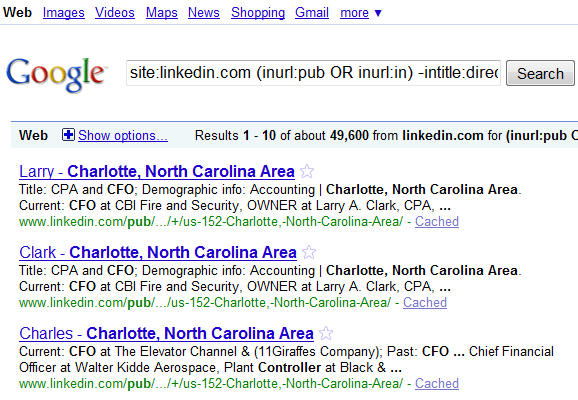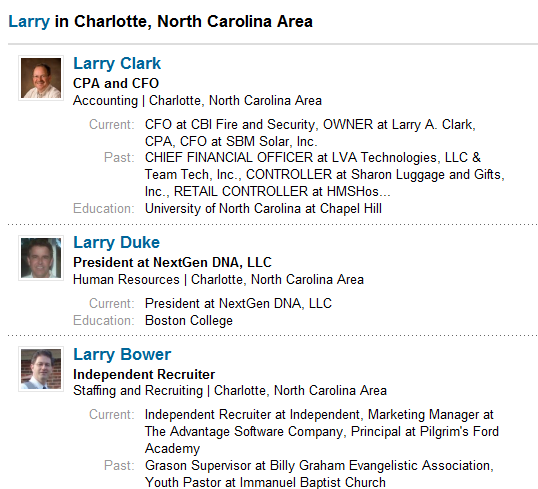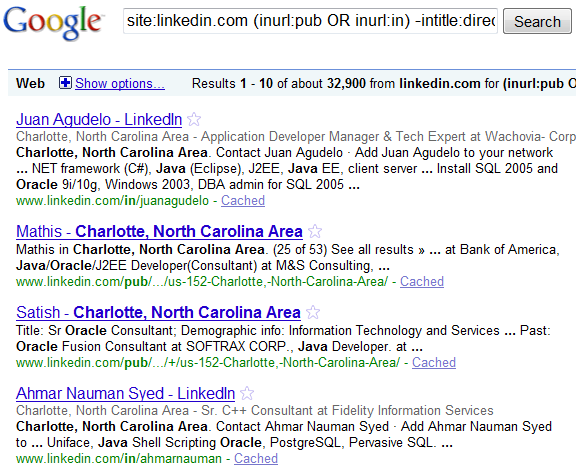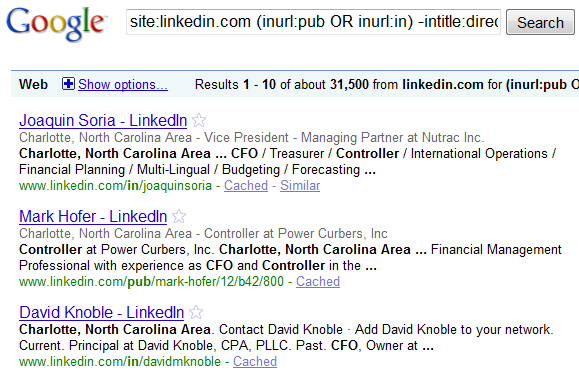 The game is afoot.
The game is afoot.
It appears that something’s happening behind the scenes at LinkedIn. Have you noticed anything odd when running a typical LinkedIn X-Ray search on Google and Yahoo?
I have. For example – try running this search:
You’ll get results that look like this:

Notice how instead of returning results of individual LinkedIn profiles – for some reason, the results come back organized by first or last name.
Clicking on the first result will take you to a page like this, where only the first result matches the X-Ray search parameters:

Hints in the URL
Notice the URL of each result:

The URL is truncated – so we’re missing some info.
If you’re using Firefox, you can drag your cursor/pointer over the result title to view the entire URL (at the bottom of the browser). Simply clicking on an individual search result will also show you the entire URL:
![]()
If you’re a search geek like me, you’re no doubt intrigued by the URL, and you’re trying to figure out exactly what LinkedIn is doing behind the scenes to take a “standard” X-Ray string and return results organized and grouped by first or last name.
I certainly didn’t search for “Larry.”
OR vs. AND
I’ve initially found that these new and different results seem to be more prevalent with X-Ray search strings using OR statements as opposed to simple AND-based queries.
For example, this 2 keyword X-Ray string brings back a mix of our more familiar individual profile results from LinkedIn as well as results grouped by first AND last name:

I haven’t yet figured out why an LinkedIn X-Ray searches with OR statements seem to have a much higher percentage of the new organized-by-first-or-last-name search results than X-Ray searches only using ANDs.
Have any ideas?
Current Title Searches
For those who are curious – configuring X-Ray searches to try and target LinkedIn profiles with specific current titles (e.g., “current * controller”) are also similarly affected.
Actually, this kind of search seems to suffer more, because the result that actually matches the current title condition isn’t typically the first search result. In fact, in one of my tests, when clicking the first search result and searching through all of the results returned by first name the only matching result on the first page was the 23rd!
The Fix
The good news, at least temporarily, is that we can easily get back to our more familiar X-Ray search results containing only individual LinkedIn profiles.
We can actually do this in at least a couple of different ways, but my preferred method works because all of the new and strange search results seem to have “dir” in the URL.
![]()
That means all you have to do is add -inurl:dir to your X-Ray search strings.
For example, adding -inurl:dir to the X-Ray search I used at the beginning of this post:
Bye bye annoying non-individual, organized-by-last-name search results!

And if you run into a result or two that happen to be jobs, you can simply add -inurl:jobs to your string to make them vanish.
Is This The End?
For the time being, the -inurl:dir seems to get us back to our familiar individual LinkedIn profile search results, even for current title X-Ray searches.
However, many people (including me) have been wondering for years as to if, when, and how LinkedIn would make changes to the ability to effectively search for and find specific LinkedIn profiles using Internet search engines.
The folks at LinkedIn have always known that people can use Internet search engines to find LinkedIn profiles that are not in the searcher’s LinkedIn network. It’s a byproduct of publishing profiles to the web, which LinkedIn does by default unless the user changes their account settings.
Are we seeing the beginning of LinkedIn attempting to reign in X-Ray capability? I’m not so sure – I would think if they were going to make a such a move, it would be more effective.
Perhaps they are testing the waters to see how they can continue to publish profiles to the web yet affect X-Ray search results?
Keep a weather eye on the horizon.
Strictly for the Search Geeks
Do any of my fellow sourcing hackers have any ideas as to:
- What exactly is going on with the search results being returned and organized by first or last name?
- What determines whether a search result is organized by first as opposed to last name?
- Why do X-Ray searches with OR statements seem to have a higher percentage of the new search results than simple AND-style searches?